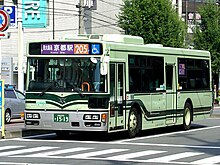
Transport in Japan is modern and highly developed. Japan's transport sector stands out for its energy efficiency: it uses less energy per person compared to other countries, thanks to a high share of rail transport and low overall travel distances. Transport in Japan is also very expensive in international comparison, reflecting high tolls and taxes, particularly on automobile transport. Japan's spending on roads has been large. The 1,200,000 kilometres (750,000 mi) of paved road are the main means of transport. Traffic in Japan drives on the left. A single network of high-speed, divided, limited-access toll roads connects major cities, which are operated by toll-collecting enterprises.
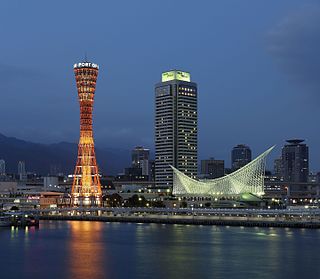
Kobe, officially Kobe City, is the capital city of Hyōgo Prefecture, Japan. With a population around 1.5 million, Kobe is Japan's seventh-largest city and the third-largest port city after Tokyo and Yokohama. It is located in the Kansai region, which makes up the southern side of the main island of Honshū, on the north shore of Osaka Bay. It is part of the Keihanshin metropolitan area along with Osaka and Kyoto. The Kobe city centre is located about 35 km (22 mi) west of Osaka and 70 km (43 mi) southwest of Kyoto.

Shikoku, Japanese pronunciation:[ɕikokɯ] is the smallest of the four main islands of Japan. It is 225 km or 139.8 mi long and between 50 and 150 km or 31.1 and 93.2 mi at its widest. It has a population of 3.8 million, the least populated of Japan's four main islands. It is south of Honshu and northeast of Kyushu. Shikoku's ancient names include Iyo-no-futana-shima (伊予之二名島), Iyo-shima (伊予島), and Futana-shima (二名島), and its current name refers to the four former provinces that make up the island: Awa, Tosa, Sanuki, and Iyo.

The Kansai region or the Kinki region lies in the southern-central region of Japan's main island Honshū. The region includes the prefectures of Nara, Wakayama, Kyoto, Osaka, Hyōgo and Shiga, often also Mie, sometimes Fukui, Tokushima and Tottori. The metropolitan region of Osaka, Kobe and Kyoto is the second-most populated in Japan after the Greater Tokyo Area.
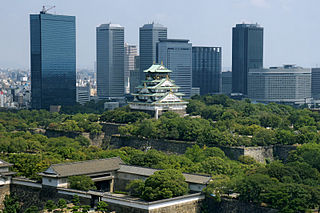
Osaka Prefecture is a prefecture of Japan located in the Kansai region of Honshu. Osaka Prefecture has a population of 8,778,035 and has a geographic area of 1,905 square kilometres (736 sq mi). Osaka Prefecture borders Hyōgo Prefecture to the northwest, Kyoto Prefecture to the north, Nara Prefecture to the southeast, and Wakayama Prefecture to the south.
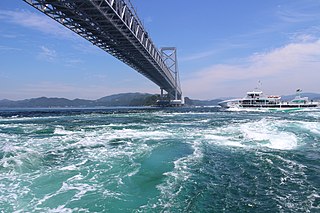
Tokushima Prefecture is a prefecture of Japan located on the island of Shikoku. Tokushima Prefecture has a population of 728,633 and has a geographic area of 4,146 km2. Tokushima Prefecture borders Kagawa Prefecture to the north, Ehime Prefecture to the west, and Kōchi Prefecture to the southwest.

The West Japan Railway Company, also referred to as JR West, is one of the Japan Railways Group companies and operates in western Honshu. It has its headquarters in Kita-ku, Osaka. It is listed in the Tokyo Stock Exchange, is a constituent of the TOPIX Large70 index, and is also one of only three Japan Railways Group constituents of the Nikkei 225 index: the others are JR East and JR Central. It was also listed in the Nagoya and Fukuoka stock exchanges until late 2020.

Ōsaka Station is a major railway station in the Umeda district of Kita-ku, Osaka, Japan, operated by West Japan Railway Company. It forms as one of the city's main railway terminals to the north, the other being Shin-Ōsaka.

The Seto Inland Sea, sometimes shortened to the Inland Sea, is the body of water separating Honshu, Shikoku, and Kyushu, three of the four main islands of Japan. It serves as a waterway connecting the Pacific Ocean to the Sea of Japan. It connects to Osaka Bay and provides a sea transport link to industrial centers in the Kansai region, including Osaka and Kobe. Before the construction of the San'yō Main Line, it was the main transportation link between Kansai and Kyūshū.

Keihanshin is a metropolitan region in the Kansai region of Japan encompassing the metropolitan areas of the cities of Kyoto in Kyoto Prefecture, Osaka in Osaka Prefecture and Kobe in Hyōgo Prefecture. The entire region has a population of 19,302,746 over an area of 13,228 km2 (5,107 sq mi). It is the second-most-populated urban region in Japan, containing approximately 15% of Japan's population.
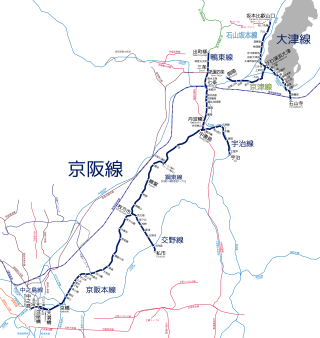
The Keihan Electric Railway Company, Ltd., known colloquially as the "Keihan Dentetsu" (京阪電鉄), "Keihan Densha" (京阪電車), or simply "Keihan" (京阪), is a major Japanese private railway operator in Osaka, Kyoto, and Shiga Prefectures. The transit network includes seven lines; four main lines with heavy rolling stock, two interurban lines, and a funicular railway.

The Meishin Expressway, or Nagoya-Kōbe Expressway 193.9 kilometres (120.5 mi) is a toll expressway in Japan. It runs from a junction with the Tōmei Expressway in Komaki, Aichi west to Nishinomiya, Hyōgo. It is the main road link between Osaka and Nagoya, and, along with the Tōmei Expressway, forms the main road link between Osaka and Tokyo. East of the Chūgoku Expressway near Osaka, it is part of Asian Highway Network.

The transport network in Greater Tokyo includes public and private rail and highway networks; airports for international, domestic, and general aviation; buses; motorcycle delivery services, walking, bicycling, and commercial shipping. While the nexus is in the central part of Tokyo, every part of the Greater Tokyo Area has rail or road transport services. There are also a number of ports offering sea and air transport to the general public.
This page lists Japan-related articles with romanized titles beginning with the letter K. For names of people, please list by surname. Please also ignore particles when listing articles.
Shikoku Kōsoku Bus Co., Ltd. is a bus company in Kagawa Prefecture, Japan. The company operates only expressway route buses.

Osaka International Airport, often referred to as Itami Airport, is the primary regional airport for the Kansai region of Japan, including the major cities of Osaka, Kyoto, and Kobe. It is the airport closest to Kyoto, 36 km (22 mi) southwest of Kyoto Station. Itami Airport has a small footprint, covering only 311 hectares of land.

Transport in Greater Nagoya (Chūkyō) is similar to that of the Tokyo and Osaka, but is more automobile oriented, as the urban density is less than Japan's two primary metropolises, and major automobile manufacturers like Toyota are based here. Still, compared to most cities of its size worldwide it has a considerable rail transport network with 3 million passenger trips daily, with a similar density and extent of passenger rail to London or New York City, complemented with highways and surface streets for private motor transport. It includes public and private rail and highway networks; airports for international, domestic, and general aviation; buses; motorcycle delivery services, walking, bicycling, and commercial shipping. The nexus of the public transport system is Nagoya Station. Every region of Greater Nagoya, also known as the Chūkyō Metropolitan Area (中京圏), has rail or road transport services, and the area as a whole is served by sea and air links.
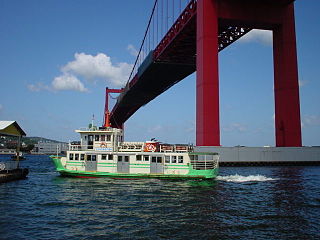
Transport in Fukuoka-Kitakyushu is similar to that of other large cities in Japan, but with a high degree of private transport. The region is a hub of international ferry services and has a high degree of air connectivity and a considerable rail transport network, complemented with highways and surface streets. It includes public and private rail and highway networks; airports for international, domestic, and general aviation; buses; motorcycle delivery services, walking, bicycling, and commercial shipping. The foci of the public transport system are Hakata Station, Tenjin Station, and Kokura Station, in Fukuoka and Kitakyushu cities respectively. Between these two cities lies a more sparse weblike regional rail network.

The Keinawa Expressway is a 104.9-km-long north–south National Highway with access control in the Kinki region of Japan that connects Kyoto Prefecture to Wakayama Prefecture via Nara Prefecture. It is numbered "E24" under Ministry of Land, Infrastructure, Transport and Tourism's "Expressway Numbering Systemg."




